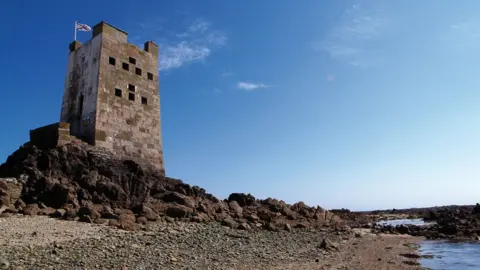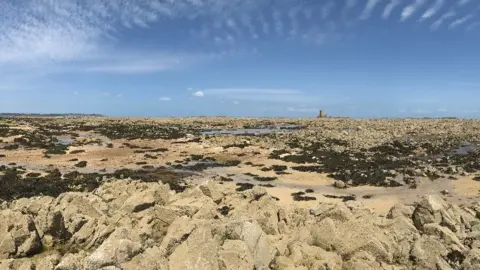Jersey 'drowned landscape' could yield Ice Age insights
 UCL
UCLArchaeologists are planning an ambitious survey of part of the seabed off Jersey where Neanderthals once lived.
The site is part-exposed during spring low tide, giving the team a four-hour window to dig while the sea is out.
Stone tools and mammoth remains have been recovered from the Violet Bank over the years.
Neanderthals are known to have inhabited what is now Jersey for hundreds of thousands of years.
The Violet Bank is a type of coastal zone known as an intertidal reef. It's underwater at high tide but some 10 sq km of seabed is exposed during the low spring tide.
In May, the team will spend a week living at an offshore fort built in the 18th Century and then digging on the seabed for three to four hours before the area is inundated.
The project's leader Dr Matt Pope, from UCL's Institute of Archaeology, said: "The Violet Bank is a starkly beautiful and scientifically important landscape.
"We know there is a record of Neanderthal archaeology, extinct fauna such as mammoth and more recent prehistoric monuments out there waiting to be discovered and documented."
The effort aims to discover records of early human behaviour, insights into the ancient environment and could shed light on past climate change.
It will seek to understand how people used this landscape before the sea covered it around 6,000 years ago.
 Dr Matt Pope
Dr Matt PopeDr Pope said: "This will be the first formal work our team has undertaken on the bank. We've undertaken brief excursions into this landscape before... now we get to base ourselves within it for a short period of time."
He said the area had been brought to the team's attention by work carried out by Société Jersiaise, Jersey's learned society.
Their members had previously documented a mammoth tooth and flint artefacts from the site.
Matt Pope explained: "Currently we only have small number of artefacts from the Violet Bank most of which have been collected by Jersey islanders with an good eye for stone artefacts. In terms of condition and technology they match Middle Palaeolithic artefacts from other Jersey sites.
"We now need to systematically survey [the area] to determine if we just have a background scatter of isolated finds across the now submerged landscape, or if we can identify concentrations that might indicate an activity area, or settlement site."
 UCL
UCLThe survey will be based on a series of short four-hour excursions from the team's base at Seymour Tower, a 18th Century fortification surrounded by sea at high tide.
The team will follow gullies in the granite, taking sediment samples and collecting stone tools and other artefacts. As the reef can be dangerous, expert guides are accompanying the team.
Jon Carter, chief executive of Jersey Heritage, a partner in the project, said: "We are delighted to be part of this exciting and ambitious project to discover more about Jersey's prehistory.
"The Island has an incredible Neanderthal story to tell and one that has already been placed on the international map by the ancient site of La Cotte de St Brelade, located on Jersey's south-west coast.
He added: "We look forward to seeing what this new and innovative survey reveals."
Neanderthals lived at La Cotte de St Brelade between 250,000 and 50,000 years ago. Some researchers believe our extinct evolutionary relatives were driving mammoths off cliffs at the site, allowing their carcasses to be butchered on the beach below.
Jersey may have been one of the last outposts of the Neanderthals in north-west Europe.
Follow Paul on Twitter.
